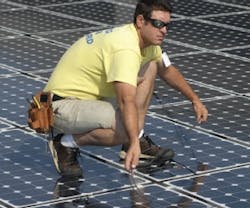Solar Installation Grows As Cost Drops
The installed cost of solar PV power systems fell nearly 17% in 2010 from the year before and dropped an additional 11% in the first half of 2011, according to an annual report by the DOE’s Lawrence Berkeley National Laboratory.
The cost reductions are partially due to a continuing reduction in the price of PV modules, as well as an 18% drop in the cost of installation, marketing, overhead, and other non-module expenses between 2009 and 2010. The falling prices contributed to a rise in both nonresidential and utility-scale solar installations despite the economic climate, according to a recent report by the Solar Energy Industries Association trade group and GTM Research.
U.S. solar panel installation in the second quarter of 2011 rose 17% over the first quarter and 69% over the same period last year, the report says. The report predicts that by the end of the year, 2011 will see nearly double the solar panels installed in 2010. Among the new installations starting this year are a statewide solar initiative by California Walmart stores and a net-zero energy development at University of California, Davis.
The 130-acre project at UC Davis will include apartments for 2,000 students, 343 single-family homes for sale to faculty and staff, a village square with retail stores, recreation and study facilities, and an education center for Los Rios Community College. The university will combine advanced energy efficiency measures with a 4 MW PV system to create the largest planned net-zero development in the U.S.
The solar system, created by California-based firm SunPower, will generate the equivalent of 100% of the community’s electricity demand, enabling the university to avoid more than 2,000 tons of carbon dioxide emissions annually. Over the system’s estimated 25-year lifetime, the university will save emissions roughly equivalent to removing 9,000 cars from roadways.
Walmart’s solar initiative will add PV panels to up to 60 additional stores in California, which will expand the retailer’s solar portfolio to over 75% of its California stores. Aiming for 130 store rooftops by 2013, Walmart plans to generate up to 70 million kWh and avoid emitting about 21,700 metric tons of carbon dioxide emissions annually. The installations will provide 20-30% of each facility’s power requirements.
